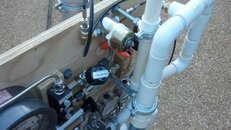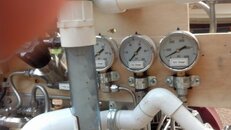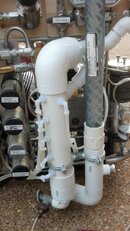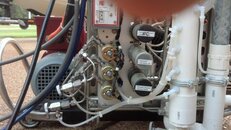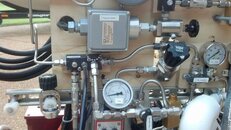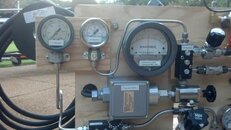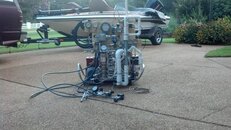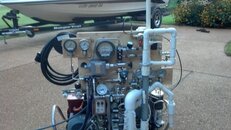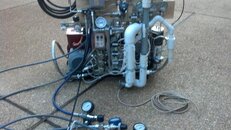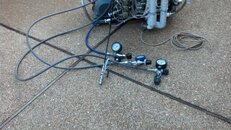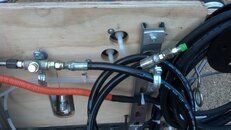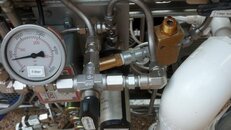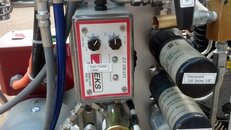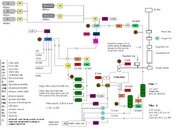vrocco
Registered
I am relatively new to this and would like some advice on how to configure my home fill station. I got a great deal on a whole setup from a guy that was doing all sorts of partial-pressure blending and filling all sorts of gases. I don't need the complexity of all that, so I want to configure things so that they work for me.
Here's what I have:
-Coltri MCH-16 Compressor (Relief Valve set at 3500psi)
-5x DOT 4500 PSI Storage tanks
-Haskel AGT-15/30 Booster
-Blending Panel
-3x Tall (33"?) Filter Towers
-Various fittings, high pressure hoses, valves, etc.
Here's what I want to do immediately:
-Fill at least 4 tanks with air simultaneously (up to 3442 high pressure steel, but mostly AL80)
-Not run my compressor higher than the 3500psi relief that is currently set (to prolong the life of the compressor)
-Fill 100% O2 for both rebreather bottles and first aid kit (Haskel would be dedicated to this)
-Not replace any more filters than what I need to to provide good breathing air (this isn't a business, while I may fill for friends, the costs will come out of my pocket)
Here's what I may do eventually:
-Add Nitrox stick for continuous blending and possibly bank 32%
Here's what I don't ever want to do:
-Partial-pressure blending (don't want the hassle of O2 cleaning everything, extra filtration, etc)
So recommendations on how to achieve what I need would be appreciated. Should storage tanks be set up as a cascade? Individually? Or in pairs? Or just one big bank of 5 tanks? Where should the fill whips be located in the flow? Where do I need check valves? Should I mess with using the blending panel as a fill panel? Or just buy a manifold and attach whips? Do I need any of the big filters? Or will the compressor filtration be enough?
Any help at all is appreciated. I know there are people here who set up these systems all the time. I'd love to benefit from your knowledge and experience and learn a little more myself along the way. Drawings, diagrams, pictures, etc. are all appreciated.
I'll try and take some pics of the equipment I have so anything I didn't explain well or call by the correct name will be clear. I'd like to use what I have as much as possible, but I'm certainly not adverse to buying extra parts in order to get the setup right.
Thank you in advance!





Here's what I have:
-Coltri MCH-16 Compressor (Relief Valve set at 3500psi)
-5x DOT 4500 PSI Storage tanks
-Haskel AGT-15/30 Booster
-Blending Panel
-3x Tall (33"?) Filter Towers
-Various fittings, high pressure hoses, valves, etc.
Here's what I want to do immediately:
-Fill at least 4 tanks with air simultaneously (up to 3442 high pressure steel, but mostly AL80)
-Not run my compressor higher than the 3500psi relief that is currently set (to prolong the life of the compressor)
-Fill 100% O2 for both rebreather bottles and first aid kit (Haskel would be dedicated to this)
-Not replace any more filters than what I need to to provide good breathing air (this isn't a business, while I may fill for friends, the costs will come out of my pocket)
Here's what I may do eventually:
-Add Nitrox stick for continuous blending and possibly bank 32%
Here's what I don't ever want to do:
-Partial-pressure blending (don't want the hassle of O2 cleaning everything, extra filtration, etc)
So recommendations on how to achieve what I need would be appreciated. Should storage tanks be set up as a cascade? Individually? Or in pairs? Or just one big bank of 5 tanks? Where should the fill whips be located in the flow? Where do I need check valves? Should I mess with using the blending panel as a fill panel? Or just buy a manifold and attach whips? Do I need any of the big filters? Or will the compressor filtration be enough?
Any help at all is appreciated. I know there are people here who set up these systems all the time. I'd love to benefit from your knowledge and experience and learn a little more myself along the way. Drawings, diagrams, pictures, etc. are all appreciated.
I'll try and take some pics of the equipment I have so anything I didn't explain well or call by the correct name will be clear. I'd like to use what I have as much as possible, but I'm certainly not adverse to buying extra parts in order to get the setup right.
Thank you in advance!
Last edited:




![IMG_20150726_154510_951[1].jpg](/community/data/attachments/155/155152-570d72bb40113e559a887d4b60347d04.jpg)
![IMG_20150726_154600_973[1].jpg](/community/data/attachments/155/155153-e4b58024a6b0c2ee6bfb3f118716de97.jpg)
![IMG_20150726_154532_809[1].jpg](/community/data/attachments/155/155154-fb159cade5d5a56aad014a6e8a28022c.jpg)
![IMG_20150726_154657_655[1].jpg](/community/data/attachments/155/155155-ff46fcdab352481030c5c623ec49d307.jpg)
![IMG_20150726_154504_592[1].jpg](/community/data/attachments/155/155156-50573fb7b4ce88995fe2eb3761985f6f.jpg)
